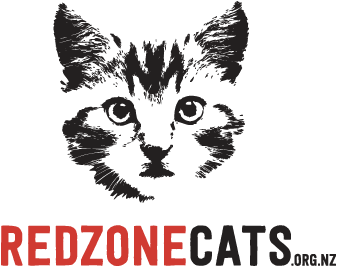
CURRENT AREAS OF ACTIVITY
RESEARCH
This population of cats in the residential red zone presents a very rare research opportunity. There are very few instances worldwide where researchers are able to observe and analyse cats in an abandoned environment.
We are currently gathering population statistics and health data for cats in the red zone, and contribute samples to a Massey University study of gut parasites. We welcome contact with research groups and hope that our data will be useful for veterinary studies and research by animal welfare organisations.
RIVER ROAD CASE STUDY

RedZoneCats activities began at this site, when a local resident, Di Madgin, wrote an article about leaving her red zoned garden. Jane offered to help Di trap a very timid cat she had been feeding for over a year – Bilbo. Since that first beginning 12 cats have been trapped at this River Road feeding station, one of whom was Hades who went straight home. There are still at least 6 homeless cats living there. This is an important site in relation to our disease testing.FINDINGSAll homeless cats are SNAP tested for FIV and FeLV
and when a feral cat we named Monty tested positive for FIV he was euthenised. Dante, also feral, tested positive for FeLV, which is considered to be rare in New Zealand,
so we ordered a PCR (DNA) test to check. This was also positive. Although the next cat Heather was negative
for both FIV and FeLV on SNAP we were concerned she might be Dante’s mother and consequently decided to undertake an FeLV PCR test, which was positive. We had advertised Heather as “Found” because she was tame, but she was unclaimed and sadly had to be euthenised because of her FeLV. Shortly after this we trapped Tiger, a feral male, and like Heather he was negative for FeLV on SNAP but positive on PCR. As a result of these findings at River Road all homeless cats trapped by us
in the red zone have been tested for FeLV using both SNAP and PCR. So far we have not found FeLV anywhere except River Road, where we think Heather may have been the primary source in a familial cluster.Another River Road cat, Ramses, tested positive for
FIV and consequently 5 of the 11 homeless cats trapped at this site have carried serious disease and been euthenised. This high disease incidence is notable because all of our other red zone areas combined have yielded only a single case of FIV.
AVON LOOP CASE STUDY

SPRING 2013When earthquake damage destroyed a main footbridge to the Avon Loop area, there were concerns about some cats being trapped in the area. A number of experimental feeding stations were situated at key locations, enabling the identification of 15 cats at seven of the sites. Some filming was also undertaken. Sites 1 to 3 were put in on the same day, and other sites followed at intervals.FINDINGSSITES 1 AND 2Site 1 became active on the third night. Site 2 became active on the second night. Two black un-neutered toms were photographed, in addition to a tortoiseshell (Cat 14 ) and a dark charcoal a dark charcoal (probably neutered) male that also showed up later at Sites 6 and 7. Site 2 was closed after a few weeks because the house was demolished. The cats quickly focused on the other sites.SITES 3Site 3 was active from the first night. A black and white cat with a flea collar (Cat 11) was photographed, as well as the older of the black toms from Sites 1 and 2. After trapping
the black and white cat, this site was closed due to the large number of dogs that visited the site daily.SITE 4Site 4 was set up after Site 2 closed and was immediately active. However, the only cats photographed were the same older black toms from Sites 1 to 3, and a lot of dogs, so this site was closed after a few days.SITES 5 AND 6Sites 5 and 6 were established after Sites 3 and 4 were closed. Six new cats were photographed at these sites, as well as two that had been seen at the earlier sites. These have not yet been trapped, due to the large number of cats already in care. However, food is taken to the feeding stations daily.SITE 7Site 7 was set up to replace sites 3 and 4, which were closed due to a high number of dogs. Site 7 was immediately active. However, when the feeding station was moved to a more sheltered position, up high on a table in the garage – a few metres from the deck – the food was not touched. After this, the feeding station was re-established in its original position. Footage showed a small black cat (Cat 13) with his collar stuck behind his front right leg. It was decided to try to trap this cat as soon as possible, in case the collar was causing distress. On examination, Cat 13 had a significant wound from the (very unsuitable) vinyl collar. This explains why the cat had been unable to get up to feed at the table in the garage.UPDATE – AUTUMN 201415 cats have now been trapped in the Avon Loop area, and 17 additional cats are still being monitored at feeding stations. None of the cats trapped in this area to date have carried either FIV or FeLV. Cat 11 was more than a kilo under his ideal weight, but he and Cat 13, who had the collar injury, are now fully recovered. Of the 15 cats trapped, only 4 had been desexed. The other 11 cats trapped included only 2 females. This is a typical gender proportion in the red zone, and is tentatively attributed to early death of breeding females due inadequate nutrition and the physical challenge of rearing litters.
NEW BRIGHTON ROAD
CASE STUDY
In early August 2013, a Canterbury Earthquake Recovery Authority (CERA) representative notified Redzonecats that they had seen a hungry kitten at an empty house on New Brighton Road. The kitten (Cat 12) was located. Although very timid, once she had been fed, she could be picked up and placed into a carry box. Cat 12 passed all of her vet tests and was later adopted and named ‘Molly’. As homeless cats are usually not on their own, a feeding station and camera were established where Molly was found.FINDINGSFour adult cats were present from the first night of surveillance, with a number of daylight images taken of all four. These images were printed and taken around several homes in the vicinity that were still occupied.Although he was not aggressive, Cat 15 is considered likely to have been feral. He has been named ‘Skaara’ by redzonecats, and features on the Adoption page. Another longhaired black and white cat looked extremely disheveled. The third cat was a lanky tabby and white cat (Cat 18) that was likely a female coming into heat, as the toms were very attentive to her, and a new extremely large tom turned up for two nights to mate with her.After enquiring door-to-door, it appeared that Cat 15 did not have a home – and disappeared temporarily when the new tom turned up in the area. After a while, two satellite stations were set up, and it was found immediately at premises approximately 200m away. Cat 15 was trapped the next day. He was un-neutered and had a number of very severe knots in his coat.The unkempt black and white tom turned out to be in the process of being adopted locally and had been named ‘Sherman’. About a week later, Sherman started showing up on camera well groomed, so had evidently been taken for neutering, and been thoroughly washed and brushed at the same time.Cat 18 – now named ‘Isis’ – and a black tom stayed on for a while. Isis was trapped and found to be pregnant. She is at least two years old and definitely had a home at one time. She has also had at least one litter and probably more. She may be the mother of Molly (Cat 12), and perhaps also the mother of the black tom at the same site. The black tom was trapped briefly, but took the back out of the haveahart trap, so was left alone.The New Brighton Road site was then closed, but redzonecats were later notified by a demolition company of a mother cat and 6 kittens in a neighbouring area. This family was successfully trapped, and 5 of the 6 kittens were female. Lucy and her family appear in Success Stories.None of the cats trapped in the New Brighton Road area carried either FIV or FeLV.
RedZoneCats website donated by The Agency Communications Ltd

RedZoneCats.co.nz 2014-2021

